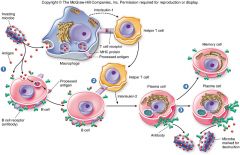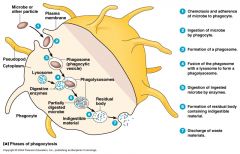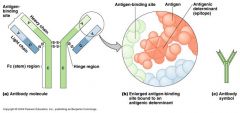![]()
![]()
![]()
Use LEFT and RIGHT arrow keys to navigate between flashcards;
Use UP and DOWN arrow keys to flip the card;
H to show hint;
A reads text to speech;
106 Cards in this Set
- Front
- Back
|
What is parasitology?
|
The study of parasites, their hosts, and the relationship between them
|
|
|
What are the major groups of parasites?
|
Protozoan
P. Platyhelminthes [flatworms] P. Nematoda [Roundworms] P. Arthropoda |
|
|
Describe protozoan parasites
|
Unicellular
Eukaryotic Heterotrophic Both parasitic & free living |
|
|
What is parasitism?
|
A type of symbiotic relationship between two different organisms where one organism, the parasite, benefits from the host and the host is harmed
|
|
|
What is symbiosis?
|
Any 2 organisms living in close association, commonly one living in or on the body of the other
|
|
|
What are the types of symbiosis?
|
Phoresis: merely “traveling” together
Mutualism: both benefit Commensalism: one benefits, other unharmed Parasitism: one benefits, other harmed |
|
|
What is predation?
|
Interaction where a predator (hunter) feeds on its prey, which may or may not be killed prior to feeding on them, but the act of predation always results in the death of the prey
|
|
|
What is an ectoparasite?
|
Parasite that lives on the outer surface of its host
|
|
|
What is an endoparasite?
|
Parasite that lives inside its host
|
|
|
What is an obligate parasite?
|
Parasite that cannot complete their life cycle without spending at least part of the time within a parasitic relationship
|
|
|
What is a facultative parasite?
|
Parasites that are not normally parasitic, but can become so when they are accidentally eaten or enter a wound or other body orifice
|
|
|
What are the variations of parasitism?
|
Non-Intimate: temporary ectoparasite
Intimate: parasitism with an intracellular stage Low – high pathology |
|
|
What is a definitive host?
|
Host in which parasite reaches sexual maturity
|
|
|
What is an intermediate host?
|
A host required for parasite development but in which parasite does not reach sexual maturity
|
|
|
What is a paratenic or transport host?
|
Host in which the parasite does not undergo any development but in which it stays alive and infective to another host
|
|
|
What is a reservoir host?
|
Any animal that harbors an infection that can be transmitted to humans, even if the animal is a normal host of the parasite
|
|
|
What is Immunopathology?
|
Branch of medicine that deals with immune responses associated with disease
|
|
|
What is zoonosis?
|
Any infectious disease able to be transmitted (Sometimes by vector) from other animals (wild and domestic) to humans, or from humans to animals (usually called reverse zoonosis)
|
|
|
What is the primary cause of damage incurred by the human body associated with a parasite infection?
|
Due to the body’s immune response to the infection
|
|
|
What are macroparasites?
|
Parasites that are large enough to be seen with the naked eye that grow in the host but multiply by producing infective stages that are released from the host, allowing the parasite to spread to other hosts
|
|
|
What are microparasites?
|
Parasite that multiplies directly within their host, usually inside host cells. They can complete a full life cycle inside a single host and generally cannot be seen with the naked eye
|
|
|
What is pathology?
|
Functional or anatomical manifestations of disease
|
|
|
What is disease?
|
Any abnormal condition of the organism specifically impairing physiological function
|
|
|
What are the classifications of disease?
|
Overt/Clinical: easily seen
Subclinical: asymptomatic carrying by an individual of a microbe, intestinal parasite, or virus that usually is a pathogen for causing illness |
|
|
List some reasons to individual variation of disease.
|
Physiology
Age Immunology General health Nutrition |
|
|
Describe the Ideal Parasite.
|
One that that is:
Able to recognize host Able to establish itself in or on host Able to adapt to environment Able to obtain nutrition Able to avoid host immune system Able to reproduce or be transmitted |
|
|
What are the parasitic environmental cycles?
|
Intrinsic cycle: within definitive host
Extrinsic cycle: outside definitive host |
|
|
What is a vector?
|
An animal that transmits a parasite
|
|
|
What are the types of vectors?
|
Mechanical: no development of parasite
Biological: parasite undergoes some extent of development |
|
|
What do the word endings iasis and itis mean?
|
-iasis: disease caused by-
-itis: inflammation of- |
|
|
What is population structure?
|
A critical piece of information for those seeking to control infection
|
|
|
What is epidemiology?
|
The study of factors affecting the health and illness of populations
•determinants/causative agents •Distribution •Injuries of disease |
|
|
How are diseases expressed?
|
Disease is expressed as a rate of number infected per population
|
|
|
What do epidemiologists do?
|
Study severity of disease
Study etiological/causative agent Life cycle agent How it enters/leaves body Survival factors Host behavior patterns |
|
|
What is an endemic disease?
|
Disease/infection that is always present within a population
|
|
|
What is an epidemic disease?
|
When disease/infection rates within a population have greater occurrences than predicted by rate of endemicity
|
|
|
What information about disease is necessary to epidemiologists?
|
Define illness
Rate of endemicity Geographic distribution Time for illness to manifest Severity of disease |
|
|
What is pathogenicity?
|
The ability of an organism to cause disease (i.e., harm the host)
|
|
|
What is virulence?
|
The degree of pathology (disease manifestation) caused by the organism
|
|
|
What are the scales of disease severity?
|
Low [L] High [H] Pathogenicity [P] Virulence [V]
1. LP/LV 2. LP/HV 3. HP/LV 4. HP/HV |
|
|
What is the goal of epidemiology?
|
To eradicate [eradication is very difficult] or control disease]
Decrease rate of infection |
|
|
What is a pandemic?
|
An epidemic of infectious disease that spreads through populations across a large region
|
|
|
In epidemiology, what is the basic reproduction rate?
|
The mean number of secondary cases a single infected case will cause in a population with no immunity to the disease in the absence of interventions to control the infection
(i.e., BRR=1, then 1 infected individual spreads infection to 1 other) |
|
|
How is the basic reproduction rate of disease decreased?
|
•Decrease
oPrevalence of infected host oTransmission oHost susceptibility |
|
|
What are challenges to decreasing basic reproduction rate of disease in low-income/lower-middle-income countries? [Underdeveloped & Developing]
|
Climate
Diversity Poverty Political Lack of community involvement Cold chain |
|
|
What is immunology?
|
The study of all aspects of the immune system in all organisms
|
|
|
What is an antigen?
|
A substance that initiates the production of antibodies and can cause an immune response
|
|
|
What is innate immunity?
|
Defense mechanism an organism has that does not require previous exposure
|
|
|
What is acquired [specific/active] immunity?
|
Immunity specific to the particular nonself material [antigen], which requires time to develop and occurs more quickly and vigorously on secondary exposure
|
|
|
What is premunition [immunity]?
|
Resistance to reinfection or superinfection, due to previous presence of the causative agent. The parasite remains alive, but its reproduction and other activities are restrained by host response
|
|
|
What is a leukocyte [White Blood Cell]?
|
Cells of the immune system defending the body against both infectious disease and foreign materials
Produced from a multipotent hematopoietic stem cell found in bone marrow Found throughout the body, including the blood and lymphatic system |
|
|
What is a granulocyte [polymorphonuclear leukocytes]?
|
Type of white blood cells characterized by the presence of granules in their cytoplasm
|
|
|
What are the types of granulocytes?
|
Neutrophils: most abundant white blood cells, and increase with infection
Eosinophils: represents about 2-5% of leukocytes, and increases up to 60% with infection [eosinophilia] Basophils: least common; regulate the behavior of T cells and mediate the magnitude of the secondary immune response; secretes pharmaceutically active chemicals |
|
|
What are agranulocytes?
|
Type of white blood cells characterised by the absence of granules in their cytoplasm
|
|
|
What are the types of agranulocytes?
|
Lymphocytes:
Have antigen receptors T-Lymphocytes: cell mediated immunity B-Lymphocytes: humoral immunity Monocytes: Amoebocytic: can leave circulatory system and enter tissue Macrophages |
|
|
What are the most important cells in fighting parasites?
|
Neutrophils
Basophils Monocytes/Macrophages |
|
|
In regards to fighting parasites, what role does the spleen play?
|
Houses large numbers of phagocytic cells, both innate and acquired, and is the primary location where antigen is processed
|
|
|
In regards to fighting parasites, what is the role of lymph nodes?
|
Location of macrophages, and is often the first line of defense against parasites
|
|
|
What is a lysozyme?
|
Enzymes which damage bacterial cell walls of bacteria and is abundant in a number of secretions, such as tears, saliva, and mucus
|
|
|
What is a defensin?
|
Antimicrobial peptides in mammals that destroy a wide range of microbes with certain conserved molecules on their surface
|
|
|
What is a tumor necrosis factor [TNF]?
|
A molecule that can cause fever with sufficient concentration; produced primarily by macrophages as mediators of inflammation
|
|
|
What is complement?
|
An important innate defense activated by alternative pathway against the invasion by bacteria and some fungi
|
|
|
What is Phagocytosis?
|
Non-specific endocytosis of a particle by a cell; is it the first line of defense
|
|
|
What are the types of acquired immunity?
|
Humoral: B-Cells produce antibodies after T-Cell stimulation
Cell-mediated: involves the activation of macrophages, natural killer cells (NK), antigen-specific cytotoxic T-lymphocytes, and the release of various cytokines in response to an antigen |
|
|
How do cell engage in complex cellular communication?
|
Through ligand-receptor interaction; [i.e., Cytokines]
|
|
|
What are cytokines?
|
Signaling molecules [proteins] that, like hormones and neurotransmitters, are used extensively in cellular communication
|
|
|
What are the classifications of cytokines?
|
Lymphokines: produced by lymphocytes
Interleukins: produces by white blood cells and affects other white blood cells Chemokines |
|
|
What are interferons?
|
Proteins produced by the cells of the immune system in response to foreign agents such as viruses, parasites and tumor cells; they inhibit viral replication
|
|
|
What are reactive oxygen intermediates [ROI's]?
|
Cytotoxic oxygen molecules/compounds released by certain defense cells that can kill invasive microorganisms/parasites
|
|
|
What are reactive nitrogen intermediates [RNI's]?
|
Cytotoxic nitrogen compounds released by certain defense cells that can kill invasive microorganisms/parasites
|
|
|
Describe the humoral immune response
|

|
|
|
Describe phagocytosis
|

|
|
|
What is an antigen-presenting cell [APC]?
|
A cell that displays foreign antigen complexed with MHC on its surface
|
|
|
What is an epitope?
|
Part of a macromolecule that is recognized by the immune system, specifically by antibodies, B cells, or T cells
|
|
|
What are 2 types of cell mediated immunity response?
|
Delayed type hypersensitivity (DTH): TH1 cells, activated by specific antigen, secrete several cytokines that lead to inflammation. Principal effector cells are macrophages
Immediate hypersensitivity (IH): Mediated by antibody (IgE) and the TH2 arm, however, in the late phase reaction, eosinophils are recruited into an area of inflammation to participate in an ADCC reaction that can kill parasites. |
|
|
What is an antibody?
|
Proteins that are used by the immune system to identify and neutralize foreign objects, such as bacteria and viruses
|
|
|
What are 2 types of cell mediated immunity response?
|
Delayed type hypersensitivity (DTH): TH1 cells, activated by specific antigen, secrete several cytokines that lead to inflammation. Principal effector cells are macrophages
Immediate hypersensitivity (IH): Mediated by antibody (IgE) and the TH2 arm, however, in the late phase reaction, eosinophils are recruited into an area of inflammation to participate in an ADCC reaction that can kill parasites. |
|
|
Describe an antibody
|

|
|
|
What are the functions of antibodies in host defense?
|
Binds to surface (antigen/antibody)
-Enzyme complement: activated & bound by antigen -Opsonization: foreign agent covered with antibody Antibody-dependent: cell-mediated cytotoxicity -Antibody on surface of invader, triggers killing by host cells |
|
|
What is opsonization?
|
Process by which a pathogen is marked for ingestion and destruction by a phagocyte
|
|
|
What is cell-mediated immunity?
|
Immune response that does not involve antibodies or complement but rather the activation of macrophages, natural killer cells (NK), antigen-specific cytotoxic T-lymphocytes, and the release of various cytokines in response to an antigen
|
|
|
What is inflammation?
|
Increased movement of plasma and leukocytes from the blood into the injured tissues. A cascade of biochemical events propagates and matures the inflammatory response, involving the local vascular system, the immune system, and various cells within the injured tissue
|
|
|
What is edema?
|
Abnormal accumulation of fluid beneath the skin, or in one or more cavities of the body
|
|
|
What is fibrosis?
|
Formation or development of excess fibrous connective tissue in an organ or tissue as a reparative or reactive process[scar tissue]
|
|
|
What is a granuloma?
|
Nodule of scar tissue
|
|
|
What is a carrier?
|
Asymptomatic host that can pass on infection
|
|
|
What is necrosis?
|
Premature or unnatural death of cells and living tissue
|
|
|
What is edema?
|
Abnormal accumulation of fluid beneath the skin, or in one or more cavities of the body
|
|
|
What is fibrosis?
|
Formation or development of excess fibrous connective tissue in an organ or tissue as a reparative or reactive process[scar tissue]
|
|
|
What is a granuloma?
|
Nodule of scar tissue
|
|
|
What is a carrier?
|
Asymptomatic host that can pass on infection
|
|
|
What is necrosis?
|
Premature or unnatural death of cells and living tissue
|
|
|
What is pus/purulent?
|
Fluid matter composed of leukocytes, tissue debris, and microorganisms
|
|
|
What is an abscess?
|
Collection of pus that has accumulated in a cavity formed by the tissue, killing surrounding tissue
|
|
|
What is an ulcer?
|
An inflammation that opens out to skin, mucous or epithelial lining
|
|
|
Why is premunition immunity important?
|
Prevents new acute attacks
Selective for avirulent strains |
|
|
Describe the World Health Organization [WHO]
|
A specialized agency of the United Nations [UN] that acts as a coordinating authority on international public health
|
|
|
List some disease monitored by the World Health Organization [WHO]
|
Malaria
Filariasis Schistosomiasis Leishmansiasis Trypanosomiasis Leprosy |
|
|
What is an acute infection?
|
Rapidly developing infection that produces relatively severe symptoms
|
|
|
What is a chronic infection?
|
Long-lasting or recurring infection, often resulting from partial immunity, in which symptoms are relatively nonsevere although pathology may be progressive
|
|
|
Contrast mortality and morbidity
|
Mortality: Measure of the number of deaths in a given population
Morbidity: The incidence rate, or the prevalence of a disease or medical condition |
|
|
What is chemoprophylaxis?
|
Administration of a medication for the purpose of preventing disease or infection
|
|
|
What is immunization?
|
Process by which an individual's immune system becomes fortified against an agent [immunogen]
|
|
|
What is hypersensitivity?
|
Undesirable reactions produced by the normal immune system. Hypersensitivity reactions require a pre-sensitized (immune) state of the host
|
|
|
What is a mast cell?
|
Type of cell in various tissues that releases pharmacologically active substances with a role in inflammation
|
|
|
What is a macrophage migratory inhibitory factor [MIF]?
|
Cytokine released by sensitized lymphocytes that tends to inhibit migration of macrophages in the immediate vicinity, thus contributing to accumulation of larger numbers of macrophages close to the site of MIF release
|

